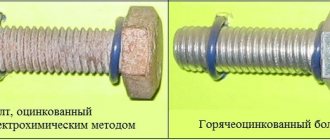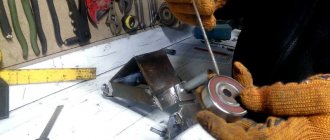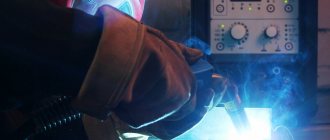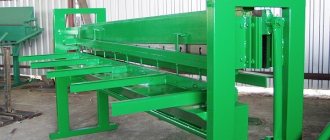When is it more profitable to do it yourself than to order a service?
Considering that the galvanic galvanizing method is expensive, in some cases it is reasonable to create a small chemical laboratory at home and do everything yourself. You can use the method at home :
Small parts after zinc treatment. Photo EnergoStal
- for small metal parts , the size of which will allow them to be immersed in a container with a zinc solution;
- for decorating metal surfaces;
- treat the most vulnerable areas of the car body or small areas of other metal structures.
Electrical equipment, light, lighting
0 votes
+
Vote for!
—
Vote against!
The most terrible disease of products made of metal is corrosion, which destroys them gradually. How can you overcome this disease? One of the methods is to cover the affected area with a mass that contains a significant amount of zinc: the proportion of its content can reach 95%. The process of creating a zinc coating on metal is absolutely nothing complicated and does not require huge financial costs.
The need for corrosion protection
Any metal needs a protective coating against rust, corrosion and other harmful influences that can destroy the product. Thanks to various metal processing technologies, it is not difficult to protect the metal surface and extend the life of the product.
In world practice, the most commonly used metal coatings are zinc. The main reasons that determine the choice in favor of zinc coatings for metal products are the low price of zinc and the cost of galvanizing, as well as the presence of a more electronegative stationary potential than iron when exposed to aggressive environments.
Metal galvanizing (zinc plating) is the coating of a metal surface with zinc, which, due to its fragility and minimal level of hardness, provides any product with reliable protection. The oxide layer on the coating is quite strong, zinc is a more active material than iron, so it significantly slows down corrosion.
Zinc reacts with corrosion faster than it gets to the main metal layer, so the part will remain untouched. And as long as at least a piece of zinc remains on the product, the iron around it will not rust. Even if the zinc coating is damaged or missing in some places, its protective properties are maintained.
Thus, zinc coatings act as protectors that are “smeared” over the surface of the protected part. Metal galvanization is mainly carried out using special production equipment using different methods. In addition, it is possible to carry out galvanizing at home.
Galvanizing methods
The procedure for applying a zinc coating to a metal product is carried out using one of the following methods: hot-dip galvanizing, cold painting, galvanic coating, gas-thermal spraying of zinc and thermal diffusion galvanizing. The method of applying a coating to a part is usually chosen depending on the conditions of future use and the desired properties of the tread layer. Several types of coatings can be used in one product.
Regardless of the choice of galvanizing method, in order to obtain a high-quality result, it is important to correctly select the thickness of the zinc coating, which depends on the time and temperature of the procedure. It should also be remembered that galvanized metal products should not be subjected to any mechanical stress.
Hot galvanizing
Zinc coatings, which are created through the hot-dip galvanizing procedure, occupy second place in terms of galvanizing production volume, and are among the best today in terms of durability and quality. Although there are environmental safety problems, which are caused by the presence of molten zinc and the use of chemical surface preparation techniques.
The technology of hot-dip galvanizing of metal consists of two stages: surface preparation and direct galvanizing of the metal. Surface preparation before hot galvanizing consists of sequentially performing the following operations: degreasing the surface for galvanizing, etching the metal surface, washing and fluxing the metal, and drying the surface.
After going through all stages of preparation, you need to dry the product. Zinc application is accomplished by using special hot-dip galvanizing equipment and immersing the dry, prepared product in a bath of hot zinc. A Fe-Zn alloy is formed on the surface of the part, which protects against corrosion.
The disadvantage of this method is that baths for metal processing are often limited in size and are not able to provide the opportunity to process the desired structure. Although a modern bathtub can easily accommodate scaffolding, lighting masts and power line supports.
Cold galvanizing
In recent years, the method of cold galvanizing metal has become widespread by painting metal products with a primer containing a high content of zinc powder. The finished coating contains 89-93% zinc. The method is highly technological and easy to perform. Sprayed zinc is applied to the surface like regular paint - using a roller or brush. You can also use sprayers for this purpose, which reduce the time for galvanizing and allow you to reach the most remote places.
This method is considered very effective for structures that cannot be processed in any other way - for example, for fixed pipes, transmission line fittings, railway track elements, oil fittings, road barriers, furniture fittings and other fixed stationary objects.
The procedure is also considered effective for repairing surfaces that were previously galvanized. Cold galvanizing of steel is carried out within a wide temperature range, and the coating is elastic, withstanding mechanical deformation and thermal expansion.
The service life of cold galvanizing can exceed the service life of hot galvanizing by 3-4 times. The disadvantages of the technique include low resistance to mechanical stress and the need to carefully monitor working conditions due to the use of an organic solvent.
Galvanic galvanizing
The galvanizing procedure creates a particularly smooth and precise zinc coating on the metal surface. This galvanizing technique involves applying a coating while performing an electrochemical action. It is suitable for conductive and non-conductive materials. The thickness of the galvanic coating is usually 20-30 microns.
When galvanizing metal, the deposited coating is of precise and uniform size, shiny, and decorative. The adhesion of such coatings is ensured by molecular forces that are observed during the interaction of the base metal and zinc molecules. The strength of such interaction is influenced by the presence of any films (oxide or fatty) on the surface of the coated product, which cannot be completely avoided during mass production.
The technology of galvanizing by electrolysis is as follows: the steel structure to be galvanized and the zinc plates are immersed in a container with electrolyte. The plates and the product are connected to a current source. The zinc anode dissolves during electrolysis, settling on the surface of the steel part.
Among the advantages of the method, one can highlight a good decorative aspect. At the same time, the electrolytic galvanizing procedure has one serious drawback: the price of galvanizing does not only consist of the cost of zinc and electrolyte. Electrochemical galvanization is accompanied by the formation of hazardous waste, so it is necessary to remove zinc from wastewater, which is a rather expensive procedure.
Thermal diffusion galvanizing
Thermal diffusion galvanizing procedure is another type of galvanizing. The TDC technique has been known for quite a long time. It was first used in England at the beginning of the 20th century and was called “Sherardization”. Subsequently, it was somewhat forgotten, giving way to other methods of galvanizing. However, since the nineties, interest in the technique has increased again.
The essence of thermal diffusion galvanizing is the formation of a zinc coating on the surface of iron due to the transition of zinc atoms into the vapor phase at temperatures above 2600 degrees, which facilitates their penetration into the iron substrate. In the process, an iron-zinc alloy with a very complex phase structure is formed. TDC galvanizing technology is used if it is necessary to create a zinc layer with a thickness of more than 15 microns.
The appearance of such a coating is possible only at high temperatures and in the confined space of muffles or retorts, which are filled with galvanized parts and a powder mixture containing zinc. In this case, metal products go through similar stages as during the hot-dip galvanizing process, and at the end they are loaded into a rotating drum furnace, where the material is coated with zinc.
The TDC technique has a number of advantages over other galvanizing methods:
- The galvanizing process is environmentally safe;
- the resulting coating has no pores and is characterized by high adhesion to the substrate due to the diffusion layer;
- the protective ability of zinc coating is 5 times greater than that of galvanic coatings;
- coating thickness varies over a wide range;
- the coating accurately reproduces the shape of parts of the most complex configuration (holes, threads, cavities, internal surfaces, cracks);
- process waste does not require disposal.
But at the same time, the TDC technique has its drawbacks, for example, zinc coating does not have decorative properties - the coating turns out without shine, and is dark gray in color. Productivity is relatively low, harmful aerosols of zinc dust are present, and zinc coating defects such as uneven thickness often occur.
Gas-thermal galvanizing
When galvanizing by spraying, coating the metal with zinc is carried out as follows: the metal is melted in the form of powder or wire, and zinc is sprayed onto the product in a gas flow. Metallized gas-thermal coatings are the optimal solution for protecting large-sized metal structures from corrosion that cannot be placed in a galvanic bath or container with molten zinc.
Molten zinc particles are deformed when they hit the metal surface, forming a so-called “scaly” coating. In this case, a porous coating is formed, which needs to be coated with a filler in the form of paints and varnishes. Such combined coatings provide long-term protection under different conditions of use - sea and fresh water, atmospheric conditions.
Galvanizing at home
Before galvanizing with your own hands, the product must be prepared and the surface properly cleaned. The better you do this, the smoother and stronger the zinc will lie. Then the metal part should be activated; to do this, lower it into sulfuric acid for 2-10 seconds. Then immediately rinse it by immersing it in water and proceed to anodizing.
Galvanizing plants can be manufactured as follows. Select dishes made of inert material - vinyl plastic or glass. If the part is small, then you can even take a liter jar. Consider the possibility of fixing the electrode and the product, which is the second electrode, on it. Suspend the electrodes on copper wire.
Take a 2-6 Ampere, 6-12 Volt charger as a current source. The electrolyte for home galvanizing can theoretically be almost any salt that dissolves in water, but in practice it is easier to prepare zinc salt. You can take battery electrolyte (diluted sulfuric acid) and place zinc in it. After the reaction stops, the zinc will remain, and the acid will turn into salt. If the acid is too concentrated, zinc sulfate crystals will form at the bottom, then slightly dilute the electrolyte with water.
After this, strain the electrolyte and pour it into a galvanizing vessel. You can make a zinc electrode from a piece of zinc, drill a hole in it and hang it on a copper wire. The surface area must correspond to the area of the product being processed, the shape must be flat and convenient for immersion in the container. By the way, a piece of zinc can be purchased at any metal collection point.
Bring the minus to the product and the plus to the zinc, the zinc electrode will “dissolve”, and a layer of zinc will settle on the part. The most difficult thing when using equipment for galvanizing and carrying out the galvanizing process itself is the galvanizing mode: zinc powder can settle on the product, which can be easily removed with a rag, or maybe a durable layer, you need the latter option.
The quality of zinc coating is influenced by the following factors:
- Current density. This indicator is calculated as the current strength, which is divided by the surface area of the product, and is 0.5 - 10 amperes per square decimeter. Use the voltage regulator to ensure that the reaction is not too violent. The coating will turn out weak and uneven if bubbles come from the part too actively.
- Temperature. Select room temperature for the electrolyte.
- Electrolyte density. This parameter can vary over a wide range - from the solubility of zinc salts to zero.
- Product geometry. If the part has a complex shape, then there may be a significant difference in the thickness of the coating, depending on the distance of the part from the zinc electrode. Build-ups appear on the sharp edge, and the coating in the recess will be weak.
Having analyzed the above, remember that it is advisable to increase the distance to the electrode, use two zinc anodes, twist the part, and experiment. It is possible to carry out galvanizing in 2 or 3 layers, with the process of intermediate removal of the formed growths on sharp edges.
Thus, when working with various metal products, you often have to deal with damage caused by corrosion. Metal and steel have a strong structure, but it cannot save it from this scourge. Therefore, to protect metal structures and structures that are especially susceptible to corrosion, the ideal option is to resort to galvanizing technology - hot-dip galvanizing, cold painting, galvanic coating, gas-thermal spraying of zinc and thermal diffusion galvanizing.
What you will need
For the galvanic galvanizing method at home, you will need the following devices and substances:
- current source. This could be a charger or a car battery. Its parameters should be in the range from 2 to 6 A and from 6 to 12 V;
- zinc sulfate – 200 g;
- ammonium or magnesium sulfate – 50 g;
Reference. Performers have the opportunity to purchase equipment for galvanic galvanizing by contacting employees of the companies that are presented in the section “Where to buy equipment (on credit, leasing).”
- sodium acetate – 15 g;
- water – 1 l.;
- container into which the parts will be immersed;
- wires for connecting to a power source.
Important. During work, be sure to use protective equipment (respirator, rubber gloves and exhaust device).
Procedure for removing red spots
First we will treat the surface damaged by saffron milk caps. Using a blade, you need to try to pick out as much paint as possible that has swollen or begun to peel off. Then the rusty area is cleaned. The next step is to wet the cotton wool in phosphoric acid; the end of the wire coming from the battery should be connected to the positive terminal on the battery. Don't forget to remove the terminal. Regarding the negative clamp, there is no need to disconnect it. The mass is the body.
Now you can burn off the rust. To do this, you need to press the side of the battery, where the cotton pad is placed, directly onto the source of corrosion. A reaction should occur in the form of a violent hiss of acid. You need to act smoothly, moving from side to side, you can’t keep it in one place. Otherwise there will be dark marks on the surface. Through the battery, zinc is transferred to the metal of the case.
We move in a similar way to the remaining rusty areas. During the galvanizing process, the wool will burn out; it needs to be changed periodically. The battery will also have to be replaced with another one as needed, since the zinc disappears on one side.
By the way, when the so-called zinc “crust” is formed, the metal surface is protected by a barrier that prevents the negative effects of aggressive substances. The created durable coating, in which zinc played an important role, is not afraid of any annoying saffron milk caps. It is also not afraid of moisture.
The advantage of this method is that it allows galvanizing of body parts, as well as individual parts. In this case, you only need your own hands and a few materials. Of course, you shouldn’t forget about desire when you want to give your car a presentable appearance and durability.
How and what to do
Galvanizing can be divided into the following stages :
- First of all, the solution is prepared in a glass container of a suitable size;
- the zinc solution is heated to a temperature ranging from 18 to 25 degrees;
- after this, the anodes are immersed in the solution, which are connected to the positive on the current source;
- At a safe distance from the zinc solution, fix the product that needs to be galvanized, and connect the “negative” wire (cathode) to it;
- after this, the galvanization process should begin, in which a zinc composition is deposited on the product through the negative wire.
Important. The current should not exceed 1 A, otherwise the coating will be of poor quality.
How to determine whether a body is galvanized or not
Most modern car manufacturers - 98% - try to galvanize the car. The type of galvanization and the degree of coating are displayed in the technical passport of the vehicle. If you purchase a car from the secondary market with significant mileage, it is almost impossible to find out whether the body is galvanized or not.
To clarify this issue, an expensive operation is needed: testing the metal using special equipment, which is only available in specialized services.
When is it more profitable to turn to professionals than to do it yourself?
To enhance the strength of a metal product using galvanic galvanization, the power of home equipment is not suitable . Therefore, if there is a need to strengthen metal products, give them strength characteristics or restore them , then in such a situation it is recommended to use the services of professionals. With the help of galvanic galvanizing, you can protect and restore the car body, but it is also better to entrust this to the professionals of the enterprises from the section “Where to order galvanic galvanizing.”
Reference. Alternatives to the galvanic method are hot galvanizing, cold galvanizing, gas-thermal, thermal diffusion. Each method has its own advantages and disadvantages.
Having started galvanizing at home, it is important to follow all the recommendations and subtleties of the process . Even though it is quite simple, it is important to be precise and do everything carefully. High-quality zinc coating of metal requires a competent approach.
A couple of minutes solves the rust problem
To remove saffron milk caps you will need your own hands and a simple device. You can make it from improvised means:
- batteries;
- knife with a sharp blade;
- electrical insulating tape;
- regular table soda;
- to protect hands - gloves made of durable material.
The list is also complemented by a one-and-a-half cable and several hygienic cotton pads. Purchase phosphoric acid in advance. It is easy to find in radio parts stores.
Regarding batteries, you will need zinc salt cells. The zinc content can be checked easily, just hold a magnet, it should not be magnetic. Then you need to completely remove the cover from the battery with a knife. Next, we wrap the battery case with a wire in a spiral shape, securing it with electrical tape. A cotton pad must be attached to the negative side of the element with electrical insulating tape.
That's it, the device is ready. This takes on average two to three minutes. With this device we will get rid of rust stains and more. They can perfectly galvanize metal surfaces.
The galvanizing process is accelerated if you first throw pieces of zinc taken from disassembled batteries into the acid. Having completely dissolved in acid and been saturated with zinc, the reaction proceeds three to four times faster.











